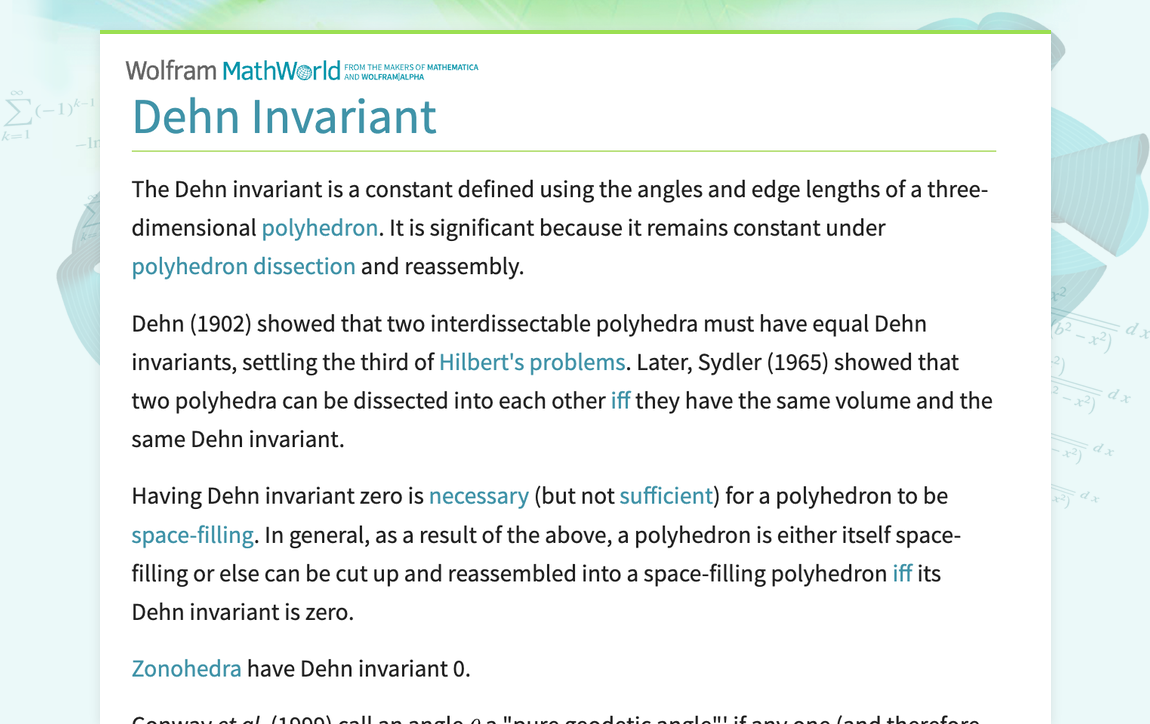
mathworld.wolfram.com/DehnInvariant.html
Preview meta tags from the mathworld.wolfram.com website.
Linked Hostnames
7- 37 links tomathworld.wolfram.com
- 5 links towww.wolfram.com
- 4 links towww.wolframalpha.com
- 3 links tooeis.org
- 1 link toreference.wolfram.com
- 1 link towolframalpha.com
- 1 link towww.amazon.com
Thumbnail

Search Engine Appearance
Dehn Invariant -- from Wolfram MathWorld
The Dehn invariant is a constant defined using the angles and edge lengths of a three-dimensional polyhedron. It is significant because it remains constant under polyhedron dissection and reassembly. Dehn (1902) showed that two interdissectable polyhedra must have equal Dehn invariants, settling the third of Hilbert's problems. Later, Sydler (1965) showed that two polyhedra can be dissected into each other iff they have the same volume and the same Dehn invariant. Having Dehn invariant zero...
Bing
Dehn Invariant -- from Wolfram MathWorld
The Dehn invariant is a constant defined using the angles and edge lengths of a three-dimensional polyhedron. It is significant because it remains constant under polyhedron dissection and reassembly. Dehn (1902) showed that two interdissectable polyhedra must have equal Dehn invariants, settling the third of Hilbert's problems. Later, Sydler (1965) showed that two polyhedra can be dissected into each other iff they have the same volume and the same Dehn invariant. Having Dehn invariant zero...
DuckDuckGo
Dehn Invariant -- from Wolfram MathWorld
The Dehn invariant is a constant defined using the angles and edge lengths of a three-dimensional polyhedron. It is significant because it remains constant under polyhedron dissection and reassembly. Dehn (1902) showed that two interdissectable polyhedra must have equal Dehn invariants, settling the third of Hilbert's problems. Later, Sydler (1965) showed that two polyhedra can be dissected into each other iff they have the same volume and the same Dehn invariant. Having Dehn invariant zero...
General Meta Tags
21- titleDehn Invariant -- from Wolfram MathWorld
- DC.TitleDehn Invariant
- DC.CreatorWeisstein, Eric W.
- DC.DescriptionThe Dehn invariant is a constant defined using the angles and edge lengths of a three-dimensional polyhedron. It is significant because it remains constant under polyhedron dissection and reassembly. Dehn (1902) showed that two interdissectable polyhedra must have equal Dehn invariants, settling the third of Hilbert's problems. Later, Sydler (1965) showed that two polyhedra can be dissected into each other iff they have the same volume and the same Dehn invariant. Having Dehn invariant zero...
- descriptionThe Dehn invariant is a constant defined using the angles and edge lengths of a three-dimensional polyhedron. It is significant because it remains constant under polyhedron dissection and reassembly. Dehn (1902) showed that two interdissectable polyhedra must have equal Dehn invariants, settling the third of Hilbert's problems. Later, Sydler (1965) showed that two polyhedra can be dissected into each other iff they have the same volume and the same Dehn invariant. Having Dehn invariant zero...
Open Graph Meta Tags
5- og:imagehttps://mathworld.wolfram.com/images/socialmedia/share/ogimage_DehnInvariant.png
- og:urlhttps://mathworld.wolfram.com/DehnInvariant.html
- og:typewebsite
- og:titleDehn Invariant -- from Wolfram MathWorld
- og:descriptionThe Dehn invariant is a constant defined using the angles and edge lengths of a three-dimensional polyhedron. It is significant because it remains constant under polyhedron dissection and reassembly. Dehn (1902) showed that two interdissectable polyhedra must have equal Dehn invariants, settling the third of Hilbert's problems. Later, Sydler (1965) showed that two polyhedra can be dissected into each other iff they have the same volume and the same Dehn invariant. Having Dehn invariant zero...
Twitter Meta Tags
5- twitter:cardsummary_large_image
- twitter:site@WolframResearch
- twitter:titleDehn Invariant -- from Wolfram MathWorld
- twitter:descriptionThe Dehn invariant is a constant defined using the angles and edge lengths of a three-dimensional polyhedron. It is significant because it remains constant under polyhedron dissection and reassembly. Dehn (1902) showed that two interdissectable polyhedra must have equal Dehn invariants, settling the third of Hilbert's problems. Later, Sydler (1965) showed that two polyhedra can be dissected into each other iff they have the same volume and the same Dehn invariant. Having Dehn invariant zero...
- twitter:image:srchttps://mathworld.wolfram.com/images/socialmedia/share/ogimage_DehnInvariant.png
Link Tags
4- canonicalhttps://mathworld.wolfram.com/DehnInvariant.html
- preload//www.wolframcdn.com/fonts/source-sans-pro/1.0/global.css
- stylesheet/css/styles.css
- stylesheet/common/js/c2c/1.0/WolframC2CGui.css.en
Links
52- http://oeis.org/A105199
- http://oeis.org/A188595
- http://oeis.org/A195696
- http://reference.wolfram.com/language/ref/PolyhedronData.html
- http://www.wolfram.com/language